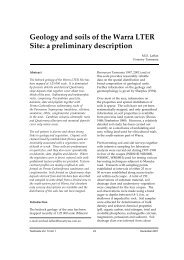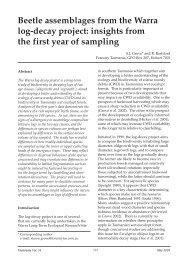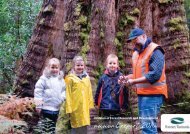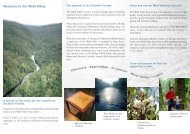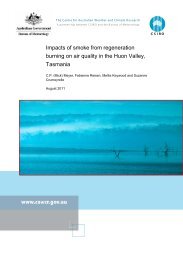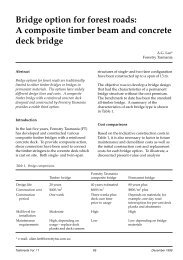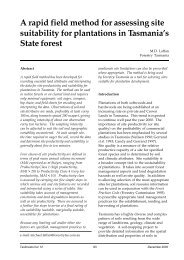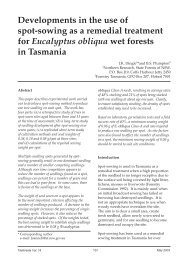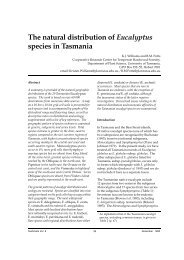sustainable forest management - Forestry Tasmania
sustainable forest management - Forestry Tasmania
sustainable forest management - Forestry Tasmania
You also want an ePaper? Increase the reach of your titles
YUMPU automatically turns print PDFs into web optimized ePapers that Google loves.
Chemical pesticides<br />
<strong>Forestry</strong> <strong>Tasmania</strong> strives to manage native <strong>forest</strong>s<br />
organically using processes that mimic nature. Generally,<br />
native <strong>forest</strong>s are pesticide (herbicides, insecticides<br />
and fungicides) free, except in exceptional cases where<br />
introduced weeds, pests and disease pose an unacceptable<br />
risk to the environment.<br />
Plantations are an increasingly significant component of<br />
<strong>Tasmania</strong>’s <strong>forest</strong> estate, providing highly productive and<br />
valuable sources of solid wood and veneer products. State<br />
and Federal Government policy initiatives, such as the 2020<br />
Vision and the <strong>Forestry</strong> Growth Plan, and transfer of native<br />
<strong>forest</strong> into reserves created under the Regional Forest<br />
Agreement and <strong>Tasmania</strong>n Community Forest Agreement,<br />
have all highlighted the importance of plantations in<br />
securing <strong>Tasmania</strong>’s economic future. For commercial<br />
eucalypt and pine plantations, pesticides are required to<br />
reduce weed and pest infestations to acceptable levels.<br />
Fertilisers are required to promote optimum growth.<br />
The usual chemical pesticide regime for plantations is to<br />
apply herbicides in the first two years and insecticides or<br />
fungicides in response to pest outbreaks. Weed control<br />
usually takes place as an initial site clean-up to remove<br />
difficult to kill species prior to planting the crop trees.<br />
Once planted, and depending on weed growth, follow-up<br />
weed control may be required in the same planting season<br />
or later in the following year. For each of these spraying<br />
operations, <strong>Forestry</strong> <strong>Tasmania</strong> prepares a comprehensive<br />
spray plan in which streams, wet areas and mandatory<br />
buffer strips are delineated.<br />
The details relating to the volume and nature of pesticide<br />
(insecticide and herbicide) applied for the purpose of<br />
weed control or pest <strong>management</strong> are shown in Tables 10<br />
and 11. They show that a total of 9877 kilograms of active<br />
ingredients were applied in state <strong>forest</strong>s. Of that 88 per<br />
cent or 8711 kilograms was applied on <strong>Forestry</strong> <strong>Tasmania</strong>’s<br />
Defined Forest Area (area certified). The remainder was<br />
applied in joint ventures and leases. In order to detect if<br />
there is any off site movement, <strong>Forestry</strong> <strong>Tasmania</strong> conducts<br />
water sampling following the broad scale application of a<br />
chemical pesticides.<br />
Table 10. Pesticide usage in plantation <strong>management</strong> by <strong>Forestry</strong> <strong>Tasmania</strong><br />
Poison Schedule Rating 2003/2004 2004/2005 2005/2006 2006/2007 2007/2008<br />
Active ingredient used (kg) Active ingredient used (kg) Active ingredient used (kg) Active ingredient used (kg) Active ingredient used (kg)<br />
Unscheduled 306 260 123 2,493 3,441<br />
Schedule 5 5,393 4,150 2,782 4,314 6,276<br />
Schedule 6 41 65 83 19 160<br />
Table 11. Pesticide usage on <strong>Forestry</strong> <strong>Tasmania</strong>’s defined <strong>forest</strong> area 1<br />
Schedule Active ingredient used (kg) Area treated (ha) kg/ha<br />
Unscheduled 2,863 9,740 0.294<br />
Schedule 5 5,755 8,311 0.693<br />
Schedule 6 92 3,686 0.025<br />
33




